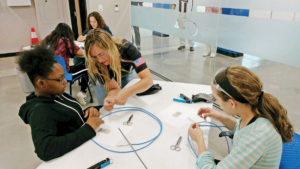Learn how to utilize apprenticeships, internships, on-the-job training and more

Public Schools, learn to wire a light switch and
bend conduit as part of a weeklong camp that
focused on careers in the construction industry.
Iowa’s 2.8 percent unemployment rate is the lowest in more than a decade. That’s good news for many but bad for businesses that struggle to find and retain workers with fewer people in need of employment.
The shortage affects businesses big and small and all industries.
Between 2014 and 2024, Iowa Workforce Development projects the biggest areas of employment in the state will be in: tractor-trailer truck drivers, electricians, industrial machinery mechanics, bus and truck mechanics and diesel engine specialists, computer-controlled machine tool operators and millwrights.
IWD reports the most job openings occur in the areas of first-line supervisors for retail workers, tractor-trailer truck drivers, registered nurses, retail salespeople, customer service representatives and first-line supervisors of food preparation. Candeo, a not-for-profit business in Johnston that helps people who have various disabilities live in the community and gain employment, is short 10 workers. These people work shifts to provide 24-hour-a-
day care to clients in the Des Moines area. These individuals provide support and supervision to clients who live in their own homes or apartments and need hourly services each day or several times a week.

“They’ve always been difficult positions to fill, but they’ve become more difficult to fill recently,” said Troy Raymer, director of clinical and community services for Candeo. “Iowa’s unemployment is low. There is a lot more competition for the same people.”
Raymer said he could easily hire at least another 10 people to fill their open positions. Employees are currently working overtime to cover all of the shifts.
In Urbandale, unemployment is even lower: 1.8 percent, the lowest since November 2001, according to recent information from Iowa Workforce Development, says Katie Gieszler, the City of Urbandale’s economic development specialist.
“Across all sectors, many companies are looking for that skilled labor,” she says, adding that the information technology sector is extremely competitive and the cost for these workers is high because of their specialized
training.
Data shows Urbandale pulls workers from a wide area: People will drive 45 minutes to an hour to work in the city, Gieszler says. A recent labor shed study showed that, of the 24,000 people who work in Urbandale, 14,000 said they would be willing to change jobs or position.
“Even though we have a lot of unemployment, the market is still flexible,” she says.
State workforce officials and elected leaders have recognized changes need to be made to prepare Iowa’s workforce for the vacancies and jobs ahead. They’ve put some plans and programs in place, including Future Ready Iowa, an initiative to build Iowa’s talent pipeline by giving people the knowledge and technical skills they need to fill the jobs of Iowa’s future.
There are other ways businesses can help. Here are five ideas for how businesses can fill worker shortages:
1. Utilize apprenticeships, internships, on-the-job training
Apprenticeships are common in the trades industries, but state officials hope more types of businesses will see the benefit in offering them.
The Center for American Progress reports apprenticeships may be a solution to the worker shortage and widening skills gap. In the United States, the Department of Labor administers registered apprenticeships and gives workers who complete an apprenticeship a nationally recognized certificate of their work.
The U.S. apprenticeship system is smaller than other countries, according to the Center, a Washington, D.C., independent nonpartisan policy institute. For example, 70 percent of young people in Switzerland enter the
workforce through apprenticeship.
Apprenticeships benefit employers by providing them with a pipeline of loyal, skilled workers who have customized skills that can meet the business’ specific needs and are more loyal to the company that invested in them; by creating greater productivity through a work environment that has a culture of learning and opportunity for its workers; and by saving money because apprentices usually earn 40 percent to 50 percent less than a fully trained employee.
The electrical field is required to apprentice its workers before they test to become journeymen electricians. There are about 260 electrician openings each year, according to data from Iowa Workforce Development. Membership into a union can provide some job protection. Members of the International Brotherhood of Electrical Workers Local 347 in Des Moines pulls in IBEW members from other jurisdictions when there’s a shortage of electricians in the metro to complete jobs.
“There’s never really a shortage completely like in a typical industry,” says Patrick Wells, the business manager of the International Brotherhood of Electrical Workers Local 347 in Des Moines.
However, Wells said the best option would be to have more workers in Iowa to fill positions. Last year during the peak construction season, there were 400 IBEW members from other jurisdictions working in the metro.
IBEW trains its workers through an apprenticeship program that begins with a pre-apprentice program called “construction wireman,” which is a way for younger people to try a job in the electrical field before they apply to the journeyman apprentice training program. It may take an individual a few years before he or she is accepted into the apprenticeship program, Wells says.
“We’re pulling in more apprentices today than we ever have,” he says.
The union pays for the apprentice’s schooling, and the individual is paid on a graduated pay scale throughout his or her five-year training.
Wells says the competitive pay and benefits are what draw most people to the electrical field and keep them.
Once an individual is done with school, he or she starts at the top rather than having to work from the ground up and is without student loans, he says.
Internships and on-the-job training are other ways businesses can ensure employees, even those who come in
with no previous experience, receive the skills they need.
IBEW in June joined with Des Moines Public Schools and other trades industries for a week long camp for girls that focused on careers in the construction industry. The 33 girls practice wiring a light switch and bending
conduit for electrical wire.
“We showed them some basic things, so they can see and feel what we do on a smaller scale,” Wells says.
Candeo provides new employees online and in-class training. They also shadow more experienced employees. Raymer says the not-for-profit is trying to increase its pool of potential workers by offering internships to high
school and college-age students.
Tradesmen International Des Moines is continually hiring workers in construction, HVAC, carpentry, electrical and other trades. Brad Watson, the project coordinator for Tradesmen, says many trades workers left the construction industry after the 2008 recession.
“A lot of people had gotten out of it,” hesays. “More people are getting back into it now, and now we have a gap of people. You would normally have that higher-level skilled guy.”
There can also be turnover in the industry. Within the first 30 to 60 days, most new workers decide whether they’ll stick with it, Watson says. That can make competition even stiffer for experienced workers.
“There is a big fight to get these skilled guys,” he says. “Everyone is fishing out of the same pond.”
All workers receive schooling that consists of on-the-job-site and safety training and classroom instruction. Most unskilled workers can be fully trained and have their license within four to five years.
“We hire skilled or unskilled craftsmen and place them with companies that work with them to support their project labor-wise,” Watsonsays. “We help them grow, and it gives them a chance to work year-round and further their skills.”
About 50 percent of those who apply to positions with Tradesmen have experience, and the age of applicants ranges from those who are 18 and fresh out of high school to 40 years old.
2. Offer additional benefits, competitive wages
The National Federation of Independent Business reported earlier this year that finding qualified workers was the top concern of small-business owners above taxation. About 54 percent reported finding few or no qualified
workers to fill open positions.
That’s why the number of small-business owners who planned to raise compensation at the start of 2018 in an attempt to retain qualified employees or attract others was the second highest in history, an NFIB Jobs Report shows.
Part of the reason Candeo struggles to fill positions is because its entry level positions are paid $11 to $15 an hour. Candeo can’t affordto pay more for the positions because it receives its funding through Medicaid and is regulated in what it can charge for services, Raymer says.
“Other employers can increase the charge to cover wage increases,” he says. “We’re a not-for-profit. We don’t have a huge margin we’re working off.”
Raymer has tried to recruit new employees by increasing referral bonuses given to internal employees for recommendations. They’ve also added sign-on bonuses for new employees who take weekend shifts, which are most difficult to fill, and a “stay-on” bonus for those who stay for a certain time period.
In the construction industry, competitive wages and consistent work are selling points to attract employees, Watson says. Offering benefits to employees also has helped Tradesmen recruit and keep more people,
especially after the tax penalty tied to the Affordable Care Act, he says.
3. Up-level current employees, those looking for career change

Middle-skill jobs make up the largest part of the labor market in the United States and each of the 50 states, according to the National Skills Coalition, a Washington, D.C.-based coalition that was founded in 1998 to help
America grow its economy by ensuring people have the skills to perform jobs. Between 2014 and 2024, 52 percent of the job openings in Iowa will be for middle-skills jobs, NSC reports. These are jobs that require education beyond high school but not a four-year degree.
About half of those who apply at Tradesmen have no experience in the field and want a new career. They’re given that opportunity to learn, Watson says.
“It’s a difficult game,” he explains. “Obviously, we want guys who can go out with experience, but everybody has to start somewhere.”
The company hires workers almost every day who are both new, some in their 40s, as well as seasoned journeymen.
Candeo has worked to improve its training to give employees more skills to create a career path to stay with and move up through the company, Raymer says.
Des Moines Area Community College works with businesses to develop non-credit and certificate programs to help fill worker shortages and to retrain current employees to take on more skilled jobs.
“The idea is that you can backfill some of those entry-level positions at a different time,” says Mike Hoffman, the director of continuing education for DMACC. “A lot of it is retainment of people they currently have on staff, so they don’t jump to another job for another $1 an hour.”
This may mean offering employees an opportunity to participate in an apprenticeship program or a certificate program through DMACC where they can learn new skills for a more advanced, higher-paying job.
Manufacturing is another industry that is struggling to fill jobs, Hoffman says. DMACC officials have helped manufacturers recruit and retrain workers to fill those positions, as well as reach out to high school students to introduce them to a manufacturing career and change the perception of the industry from a dirty place to work to one where math and robotics are used.
DMACC has more than 60 non-credit certificate programs. Some involve tuition assistance through grants; others are done in conjunction with businesses. These include trades areas such as blueprint reading and welding, healthcare careers that include learning how to intake patients and bill, and culinary careers and hotel management.
A non-credit program trains an individual more quickly and can provide individuals with the skills they need and put them on the career path faster, Hoffman says.
“Everything we develop is based on industry need and demand,” he says. “If the demand isn’t there anymore, we don’t want to offer something if people aren’t going to be employable.”
One area that’s currently being discussed is a social media/marketing certificate that would train individuals on how to use Facebook and other social media for business purposes based on need from the business community, Hoffman says.
4. Tap into state programs

Several state-funded workforce training programs that local community colleges administer are available to
businesses. The programs provide soft skills, technical and on-the-job workforce training.
When Urbandale officials share information about the programs with businesses, many are unaware such
programs exist, says Curtis Brown, Urbandale director of economic development.
Iowa Workforce Development’s registered apprenticeship program works with the Iowa Economic Development Authority and businesses across the state to increase apprenticeships. More than 1,400 occupations can be apprenticed through the DOL from the traditional skilled trades positions to healthcare and the financial industries, Amy Beller, the program’s coordinator, says.
Apprenticeships work for companies because “you are broadening your pool of applications because you are
hiring based on potential rather than credentials,” she says. “You’re training the person up so they become a
skilled worker.”
Any business, regardless of size, is eligible to meet with an IWD business marketing specialist to work through its needs and decide how to utilize the registered apprenticeship program. The only requirement is that the businesses have a one-to-one ratio of skilled worker/mentor to apprentice.
Grant money is available through the state for on-the-job training and apprenticeship programs if the business meets certain requirements. The state is accepting requests for proposal through July 27 at this link: https://bidopportunities.iowa.gov/Home/GetBidOpportunityDocument/db177c29-9d96-46e4-80b8-c83eba07668e
5. Explore other options
Of the 2 percent of people who are unemployed, Hoffman with DMACC suggests looking more closely at those
individuals.
“Most businesses are struggling because the number of people aren’t there with the unemployment number being so low,” Hoffman says. “Where do you go for those positions?”
An option could lie with training prisoners and preparing them for appropriate jobs based on ability and crime for areas where there are shortages in workers, he says.
Raymer says employers need to remember individuals with disabilities when they are considering prospective employees. Although the state unemployment rate is low, 35 percent of disabled people are unemployed.
“We need to help people with disabilities find competitive employment doing real competitive jobs,” he says. “We have folks who work in all sorts of different places. They are another option that’s an untapped resource.” ♦


superbeets
Hello everyone, it’s my first go to see at this website, and post is actually fruitful designed for me, keep up posting these types of posts.|